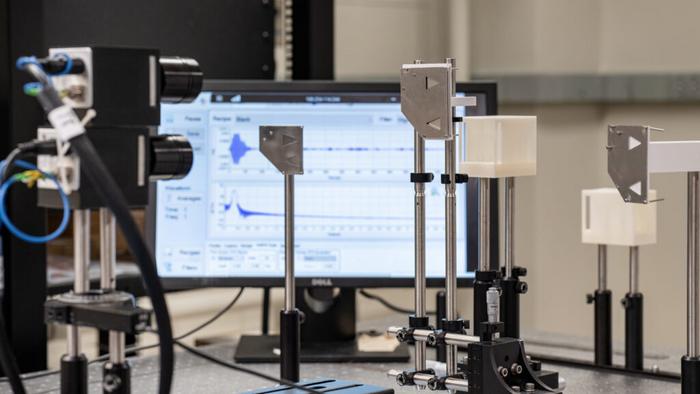
Researchers at Princeton University, Rice University, and Brown University have made significant strides in wireless communication technology by developing a groundbreaking sub-terahertz data backscatter tag that could revolutionize how machines and devices communicate. This innovative tag represents an advanced iteration of traditional wireless systems, enabling a vast array of devices to share information efficiently without the burden of conventional power-consuming signal transmitters.
The essence of this new technology lies in its ability to utilize high-frequency backscattering while maintaining energy efficiency. Backscattering is a technique wherein a central reader emits a signal that is then reflected back to it by sensor tags. This approach allows for real-time monitoring and has numerous practical applications, particularly in industrial fields like manufacturing and gas detection. By implementing this technology, factories could revolutionize their operations, allowing for better monitoring of equipment and immediate detection of anomalies without the need for extensive and expensive transmitter networks.
Until now, the utility of backscattering was limited to low frequencies, which posed significant limitations on communication capacity and speed. As more devices join a low-frequency network, signal interference becomes a major concern, leading to jumbled communications that can severely hamper operations. Therefore, the research team’s transition to high-frequency sub-terahertz ranges is a game-changer—facilitating higher communication speeds and the capacity to support a greater number of devices operating simultaneously.
The team’s advancements suggest that these tags could dramatically reduce the energy consumption typically associated with wireless communication. Conventional methods rely on active power-hungry transmitters that drain energy and complicate infrastructure requirements. By harnessing the passive nature of the new sub-terahertz tags, researchers have illustrated a pathway to a vast array of applications, from smart city implementations to agricultural monitoring solutions, underpinned by sustainable practices and reduced energy footprints.
“This technology opens doors to applications previously thought unattainable,” said Yasaman Ghasempour, an assistant professor of electrical and computer engineering at Princeton, who takes a leading role in this research. Ghasempour highlights how, contrary to popular belief, low-power, scalable communication within high-frequency ranges is entirely achievable. This paradigm shift illustrates the potential to reshape how devices interact across various sectors, paving the way for smarter, interconnected environments.
From the technical perspective, the challenge introduced by high-frequency operation is the signal attenuation that occurs over distance. The research team faced the task of ensuring that the signals emitted from the reader could maintain their integrity when reflected back from the tags. This necessitated the development of a novel architecture for the tags that could adaptively steer signals, thereby minimizing interference and improving the accuracy of the communication.
Standard backscatter systems employ simple antennas that radiate energy indiscriminately, which limits the distance over which effective communication can occur. The newly developed antennas not only transmit signals but do so with directional precision that is responsive to changes in frequency. This significant advancement allows for longer communication ranges while simultaneously reducing the interference footprint associated with each device. Furthermore, Ghasempour emphasizes that the innovation required an overhaul of traditional hardware configurations, indicating that a simple scaling of existing technologies would not suffice.
Utilizing these advanced antennas, the tags are designed to track the ‘pencil beam’ of the reader’s signal, ensuring a focused and effective data transfer process with minimal power consumption. This innovation is critical for applications requiring reliable data from various sensors; for instance, in urban settings where vast networks of devices need to communicate efficiently without depleting energy resources.
Looking ahead, the researchers hope that their innovative contributions will stimulate new lines of inquiry and further engineering advancements that can optimize the technology for practical use on a large scale. The potential applications are extensive. For example, in agricultural settings, tags could be deployed across fields, contributing to an expansive network of soil moisture sensors that would relay real-time data on environmental conditions. This information could enable farmers to make more informed decisions, optimizing their resource use while minimizing waste.
In urban environments, the newly developed tags could be particularly beneficial for transportation systems. They could be strategically placed on traffic signs, providing vital information to self-driving vehicles that rely on precise communication for making decisions in real time. The use of radio waves for data transmission can dramatically enhance the safety and efficiency of autonomous systems, particularly in adverse weather conditions where visibility may be compromised.
The creation of low-power data modulating systems is an important and active field of study. As Ghasempour and her colleagues continue their research, they remain committed to further decreasing the costs associated with this technology while simultaneously reducing the power consumed in the entire wireless network. The implications for smart cities, enhanced manufacturing efficiencies, and sustainable agricultural practices continue to expand as this technology gains traction.
In conclusion, this research represents a significant leap forward in the realms of wireless communication, energy efficiency, and device interconnectivity. By harnessing the potential of sub-terahertz backscattering, researchers are not only pushing the boundaries of what is technologically possible but are also laying the groundwork for a more efficient, interconnected future.
Subject of Research: Sub-terahertz data backscattering technology for large-scale signal sharing
Article Title: A frequency-agile retrodirective tag for large-scale sub-terahertz data backscattering
News Publication Date: October 9, 2024
Web References: Nature Communications
References: DOI: 10.1038/s41467-024-53035-5
Image Credits: Princeton University/Sameer A. Khan
Keywords
Sub-terahertz, data backscattering, wireless communication, energy efficiency, smart cities, agricultural monitoring, autonomous vehicles, signal transmission, device interconnectivity.





